LP12MF Listening Test: Dynavector XX-2 mkII Cartridge
In the first installment of the LP12 Modification Frenzy in the Coronavirus Era, I install a Dynavector XX-2 mkII moving coil cartridge. You can read about the installation process for the XX-2, and check out my listening methodology. Full listening impressions on the XX-2 are below; digestible, numerical summaries of all my listening tests are here.
tl;dr
Things have been crazy in the world. You probably haven’t come to hi-fi AF to hear my thoughts on COVID-19. It’s scary and awful. And by trapping me inside my home with my record player, it has no doubt accelerated the speed and intensity of the LP12MF. For it is a very welcome distraction…
I was definitely hoping for a big improvement going from a moving magnet to a moving coil cartridge. And I definitely didn’t get it.
Instead, there was a huge regression here: on average, my test tracks sounded 15.4% worse with the Dynavector XX-2 installed versus the Linn Adikt. Most tracks sounded significantly better than my digital setup before installing the XX-2; afterwards, most of them (with a few weird exceptions) sounded only marginally better. It was without question the worst “upgrade” — a bit like hitting a long snake in Snakes and Ladders.
There are many possible reasons for this, none of which is necessarily an indictment of the XX-2 or of moving coil cartridges in general:
- The cartridge wasn’t aligned. This is the most likely problem. As you can see in my installation notes, my custom-made Mint LP Best Tractor cartridge protractor arrived flawed and unusable. I used a sensible method to get things pretty much right, but it’s almost certain that the alignment was at least a little bit off. (Having said that, there were no obvious audible signs of alignment issues: no inner groove distortion or sibilance.) (Update: using a proper Best Tractor when aligning the XX-2 on a Linn Ekos arm, I did need to cock the cartridge body slightly relative to the headshell, indicating a stylus that’s at a slight angle to the cartridge body. So it was probably out of alignment on the Nima.)
- The XX-2 is a bad match for the Roksan Nima tonearm. Although I’ve heard people say they love the XX-2 in the Nima, this is a fairly premium cartridge in a budget tonearm. The annoying “thuddy” quality to music in this round could very well have resulted from a cartridge/arm mismatch.
- The cartridge needs more run-in. I bought this cartridge used from someone I trust, who said it had about 50 hours of use. I listened to it for about another 50 hours during this listening test. That should be plenty… but who knows?
- Something else happened during installation. Hard to say what exactly, but who knows? One possible issue could be the arm lead connection. I had to raise the arm significantly in the collar with the XX-2, which is much taller than the Adikt it replaced. The way the Nima works, raising the arm meant that there was less space to attach the connection with the tonearm lead — and there is no grub screw in the Nima to hold it in place. It was definitely fairly loose — indeed, it fell out when I carried it up to my office after setting it up initially. Something like that could definitely cause an audible effect like the dreaded thud.
I’m writing these notes out after having installed the XX-2 on a different tonearm — the Linn Ekos 2 — and things seem to be sounding much, much better. But then again, it’s properly aligned, the Ekos is a much fancier tonearm, it’s been run in a little more, and the arm lead is held in place with a grub screw. So that doesn’t reveal the culprit.
Notes on casual listening
From the first tracks, I noticed a flatness and hardness to the music with the XX-2 installed. On highly percussive instruments — drums, vibraphones, xylophones — I noted the dreaded “thud.” I fiddled with the settings on my Dynavector P-75 phono preamp, switching from “Phono Enhancer” to standard MC mode, but it made no difference.
Some discs sounded really good — most notably Wayne Shorter’s Et Cetera in its recent Tone Poet guise. So did certain tracks on A Conference of Birds. Detail and texture were particularly good on horns. But when drums entered the picture or anything was being hid hard, the thuddy flatness came back in the picture. I found Miles Davis’s E. S. P. hard to take with the thudiness.
Once I started doing listening tests and seeing that a lot of individual tracks were coming up 20% or more worse than the previous setup, my casual listening seemed to confirm that. Things still sounded good — about as good as my digital setup — but but the thud was a big problem. So I didn’t linger long on this stage — I proceeded quickly to the installing the Ekos + Kore setup.
Test tracks
1. The Beach Boys, “I Know There’s an Answer,” Pet Sounds (1966)
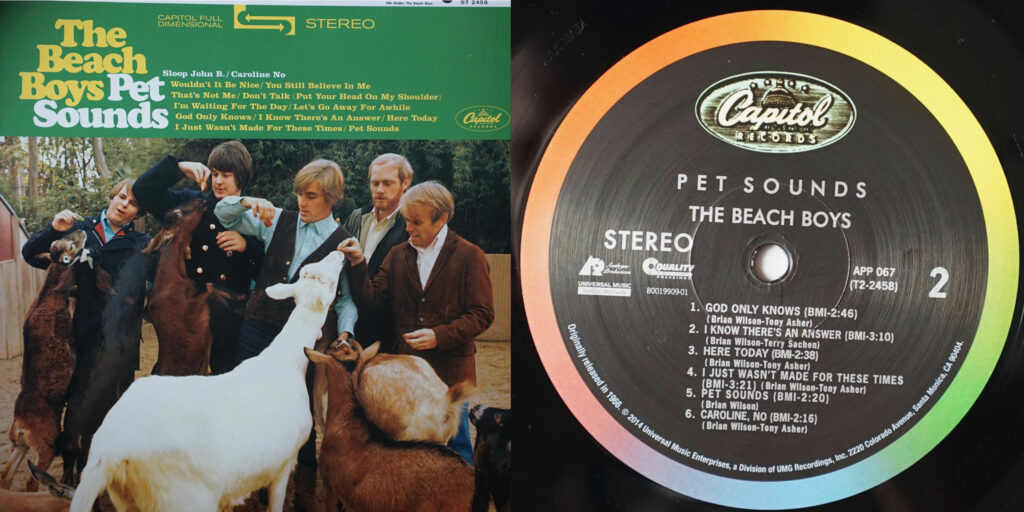
Full digital. After about a week of listening to music on the XX-2 and finding the music maybe a bit “thuddy” and underwhelming, this noticeably sounds very good. Could be that this is because the XX-2 really isn’t sounding all that special. But then again I haven’t been listening to this track… The timpani do sound a bit dull, lacking impact. The shakers have a bit of the “pixel-barf” I once described. Fine details are lacking… the “filigree.”
Full vinyl. Whoo, definitely a lot better. Bass is deeper, Brian Wilson’s vocals sharper, the shakers far more present, fine, detailed. Timpani definitely more impactful. (I do still hear some of that “thud” effect, though). The separation of instruments in the bass harmonica breakdown part is really impressive and new. Also: vinyl is now much louder with the phono preamp set up the way it is. Will make direct comparisons a bit of a challenge in terms of equalizing levels.
Slight delay. This is big — a big, big difference. Things are really, really tinny on digital. Very thin. Vinyl is rich but not bloated: all the detail but much more colour. It’s also a soundstage thing: much wider, more clear on vinyl. Feels like a 25% difference or so, which is a big jump from last time.
S-2-s. Glaring difference in smoothness, richness, and detail. Definitely “beyond gross” going from one to the other. Big jump.
Verdict: Vinyl is 25% better (10% improvement)
2. Charles Mingus, “Track B — Duet Solo Dancers,” The Black Saint and the Sinner Lady (1963)
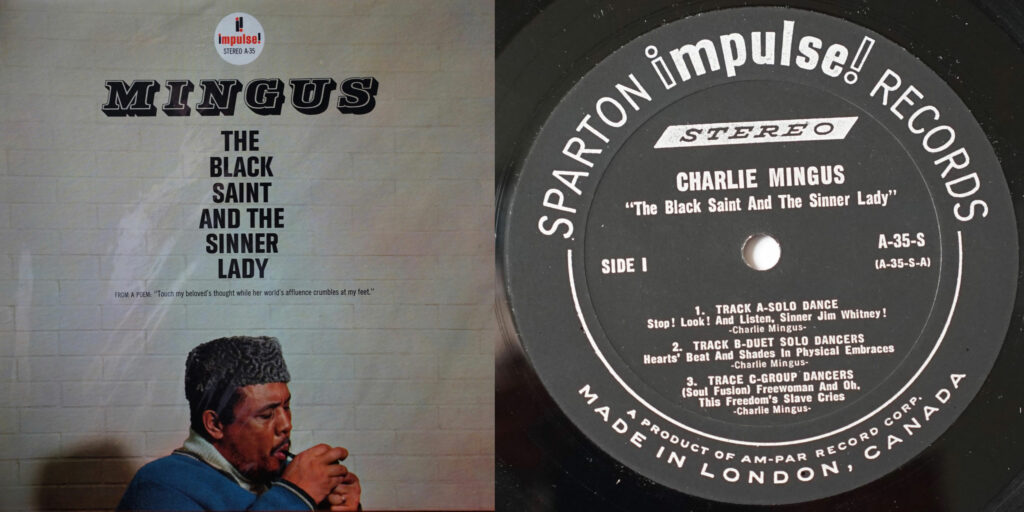
Full digital. I’m noticing the same things as last time: weirdly hard-panned effect, brightness and harshness of tone. Note that this is not something I was commenting on in earlier rounds. My ears are becoming “educated” and I am starting to demand a nice wide soundstage, realistic presentation of instruments in space, sounds that are detailed but not harsh…
Full vinyl. The annoying surface noise on this copy isn’t lessened much or at all with the XX-2’s stylus (something I was sort of hoping for). I usually complain about graininess on this pressing but I don’t perceive it now — it sounds really excellent, full and detailed, with great soundstage. The “cordy sax” sounds amazing, very nicely detailed. Very pleasant.
Slight delay. Vinyl has the cymbal texture and the spatial positioning. No difference in detail (which is to say, vinyl has caught up a lot in this department). Digital definitely much more “tiring” and grating. Quiet drum part equally detailed on both, but trumpet solo in that section much smoother and less grating on vinyl. Quiet details and cymbals massively better on vinyl.
S-2-s. Vinyl has closed the gap on detail (now totally equal) and maintained its advantage in terms of “colour,” cymbal texture, and spatial presentation. Still not a massive difference, but much more pleasant on vinyl.
Verdict: vinyl is 15% better (10% improvement)
3. The Pentangle, “Let No Man Steal Your Thyme,” The Pentangle (1968)
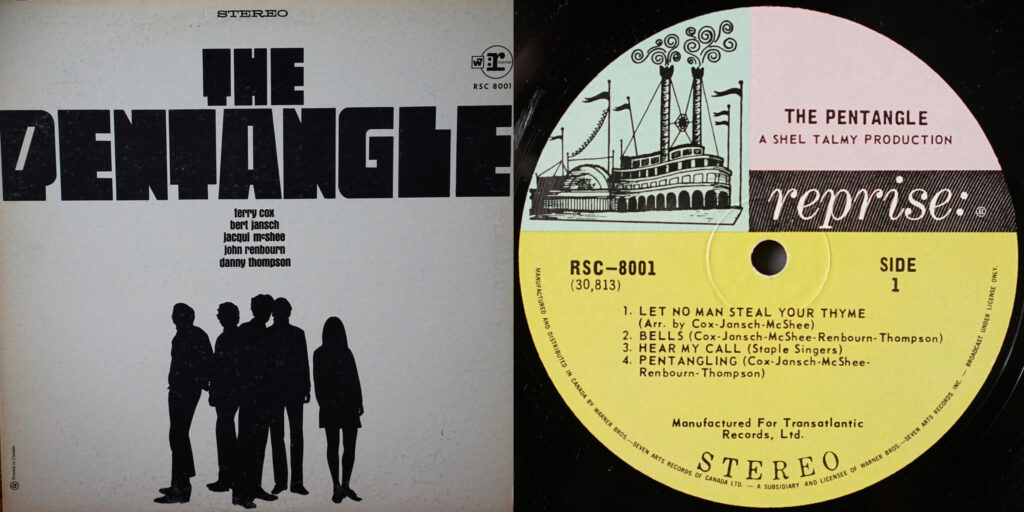
Full vinyl (Reprise). This much-complained-about pressing now sounds really very nice. I do not hear the surface noise or graininess I previously complained about, amazingly. So the XX-2 has made a difference there. Space and detail amazing in the quiet rim-tap section. Wow.
Full vinyl (Transatlantic). But yes, the difference between these two pressings is large. Bursting with texture, detail, and colour, especially in Jacqui’s voice, in the bowed bass, and the guitars.
Full digital. Less bad coming after those two than I might have expected. We shall have to turn to the direct comparisons now…
Slight delay (Reprise). Slightly congested sound on vinyl compared with digital. The vinyl evens off some of the harshness of the digital, so it’s more pleasant, but I wouldn’t say it’s even 10% better. 5%?
S-2-s. For slightly better texture on guitars and bowed bass, a 5% nod to vinyl. But a regression on this disc, I think.
Verdict: Reprise vinyl is 5% better (5% regression)
Slight delay (Transatlantic). Texture, space, detail: 25% better. But no more than that, I don’t think (so no improvement over last time?)
S-2-s. Yes, 20-25% better — might as well say 20% to be conservative — but no improvement over last time, I don’t think. Interesting…
Verdict: Transatlantic vinyl is 20% better (5% regression)
4. Mariah, “Shinzo No Tobira,” Utakata No Hibi (1983)

Full digital. So much coronavirus madness out there (writing on March 20th). Time for something else. Okay. So: yes, those rattles sound nice, as ever. Maybe a little flat, harsh on the snare, a little unfocused on the bass. But the width that the rattles produces is really beautiful. If I heard this with no context, without a comparison to vinyl, I’d be very satisfied and impressed with my system and the production. So, naturally, I’m excited to hear it sounding much better on vinyl…
Full vinyl. Last time, I reported an immediate perception of a big difference. Not this time. Maybe it’s a volume/level thing, but the rattles don’t sound obviously better. When the bass kicks in — once again, not obviously better. More bass, but a little boomy. The vocals do sound better: clearer, better-positioned. Drums, especially snare and toms, sound better, more lifelike. Analog synth sounds very satisfyingly crunchy. But not a night-and-day difference in the full-song comparison.
Slight delay. Really not much of a difference between them. A bit more detail on the snare on vinyl, but not nearly the 25% of the last round. 5%? 10%?
S-2-s. A very, very slight edge to vinyl. Just a very slightly nicer timbre on vinyl. Something’s up! Alignment, maybe? Arm/cartridge combination? The next round will be interesting!
Verdict: vinyl is 5% better (20% regression)
5. Joy Division, “Atmosphere,” 12″ single (1980)
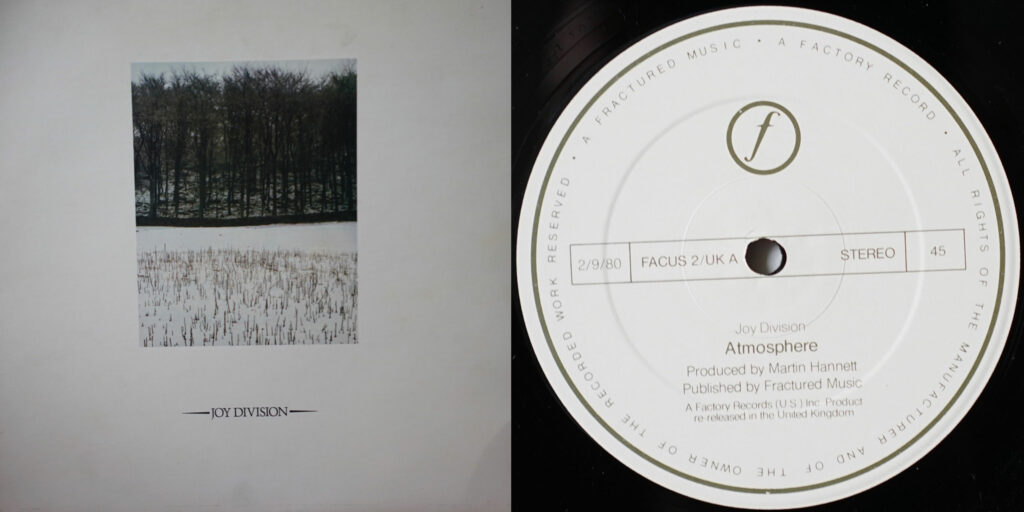
Full digital. This will be an interesting test. This sounds good, not great: drums a bit chalky, boxy. Shakers, synths are blocky.
Full vinyl. Definitely better. But not tempting me to scream or freak out as previous rounds have done. There is a hardness, a thumpiness to the tone, particularly the famous toms.
Slight delay. Just not like before. Toms are much more impactful, but they’re rounded off by that thuddy quality I identified early on with the XX-2. Really spoils the experience here. 15% better or so, definitely not “gross” to switch to digital now. Surprising.
S-2-s. More like 10%. Another possibility is that the XX-2 needs to be further broken in. But it’s not making the system sound any better than the Adikt at this point. Indeed, it’s making it sound quite a bit worse.
Verdict: vinyl is 10% better (20% regression)
6. Low, “Just Make It Stop,” The Invisible Way (2013)
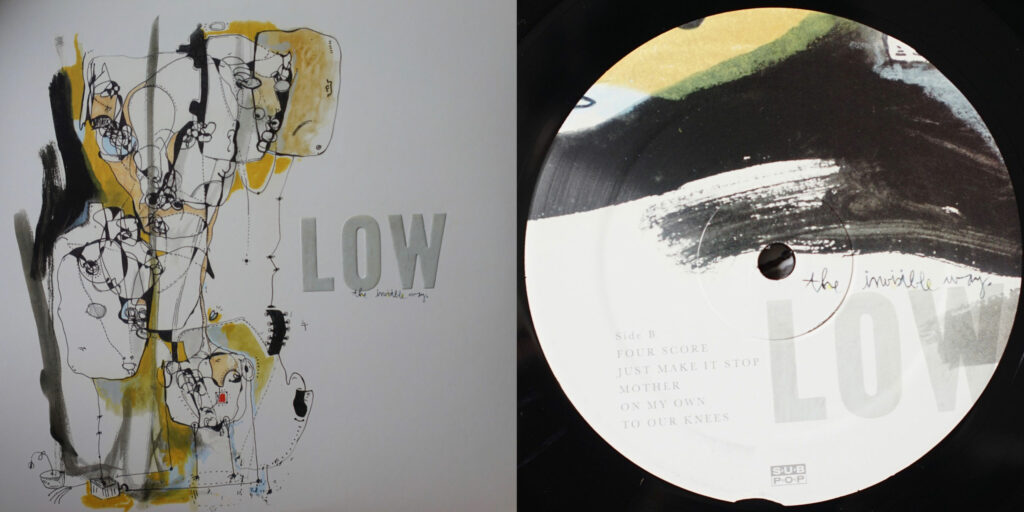
Full digital. As usual, a nice-sounding track. A little indistinct in the bass, compressed in the vocals. Not expecting much from vinyl after the last two tracks. (So weird that the first two tracks in this test sounded better, and now these ones sound so much worse. Has something happened? Is it that The Beach Boys and Mingus tracks don’t have enough percussive instruments to register the “thuds”?)
Full vinyl. Vocals much clearer on vinyl. Bass seems both fuller and more defined. The thuddiness, though, persists…
Slight delay. Once again, the differences are minor. Vocals clearer, cleaner. But the overall profile is very similar. 5 or 10% better on vinyl.
S-2-s. 5%. Very, very similar — including a confused, muddy soundstage in loud parts. Only advantage is slightly more natural vocals and cymbals.
Verdict: vinyl is 5% better (20% regression)
7. Yo La Tengo, “Stockholm Syndrome,” I Can Feel the Heart Beating as One (1997)
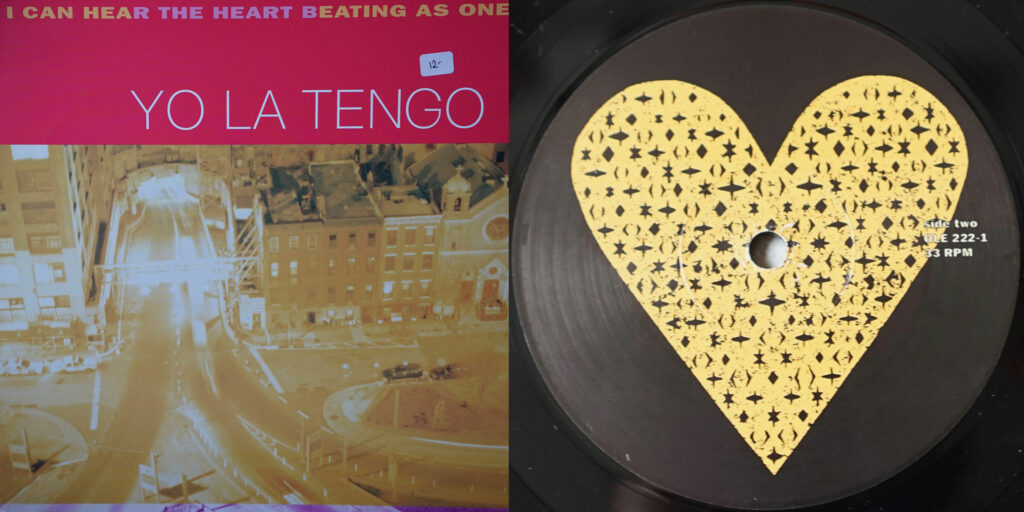
Full digital. Yeah, meh. Not a terrific digital track, not a very pleasant listening experience. The difference was 35% (!!) last time… I wonder what it’ll be this time. (I’ve been listening to jazz while working all day today, and it definitely sounded good — but, man… the listening tests so far this round have been bleak.)
Full vinyl. Congested and dull. The acoustic guitar sounds better, I think, and the cymbals are sharper, but overall this is muddy and sounds nasty. Can’t get that Ekos on fast enough…
Slight delay. Okay, quite a bit better on vinyl. Nice detail on acoustic guitar, much livelier, more dynamic. But the bass is a disaster: confused, thuddy, dull. I really hope this isn’t just an inherent property of the cartridge.
S-2-s. Better detail, wide soundstage, nicer acoustic instruments on vinyl… but a muddier, more confused presentation. 10% better.
Verdict: vinyl is 10% better (25% regression)
8. The Beatles, “While My Guitar Gently Weeps,” The White Album (1968)
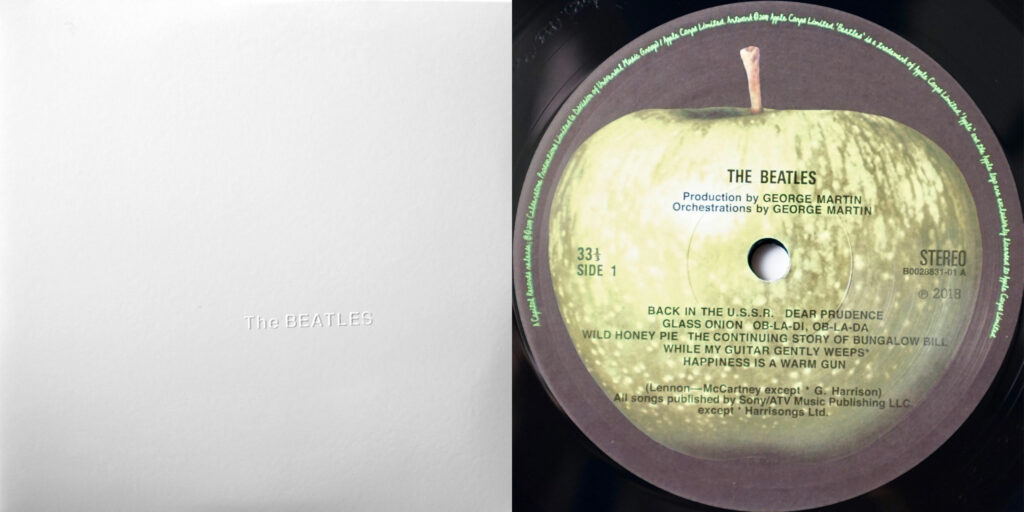
Full vinyl. Starting with vinyl this time. Bass sounds thuddy, busy. Acoustic guitar sounds nice and detailed. But thuddiness reigns, drowning detail and finesse.
Full digital. The acoustic guitar is zingy and sharp, harsh. But this sounds better to me than the vinyl: solid impact on bass, good detail. Just that shrill, tinny quality on treble.
Slight delay. Despite the boomy bottom end, the detail on the acoustic guitar and the clippety-clop is much better on vinyl, as is the impact of drums. But when things get noisy and busy, it’s just too much on vinyl — confused, hazy. Neither is very pleasant. Vinyl is maybe 5% better overall.
S-2-s. As above. It’s detail vs boom on vinyl, sharpness vs haziness on digital.
Verdict: vinyl is 5% better (25% regression)
9. Dungen, “Panda,” Ta Det Lugnt (2004)

Full vinyl. My beloved drums sounds… pretty good, but a little thuddy. Lack of focus, boomy. Not bad by any means, but not like before…
Full digital. Wow, it’s been a while since these drums sounded better on digital than on vinyl, but I’m pretty sure they do here…
Slight delay. Well, not better on digital, but very close, probably a tie. The distorted electric guitars sound sharper, more alive on vinyl, though. The boomy bass and the thuddiness are here, but there’s a harsh glare to the digital that is gone on vinyl. Vinyl wins by a bit for the pure rock stuff by some margin here. Much smoother on the top end while hitting much harder on the bass notes (especially lower crunchy guitar notes). Pretty awesome rock experience on vinyl, actually. 15% better?
S-2-s. Treble much smoother, cymbals much more detailed on vinyl. The treble is so de-emphasized on vinyl that some detail is lost, but it does make the song sound quite a lot better. I’m not sure I’d always want to sacrifice this much treble or have this much bass, but it works here.
Verdict: vinyl is 15% better (15% regression)
10. Julee Cruise, “Rocking Back Inside My Heart,” Floating Into the Night (1989)
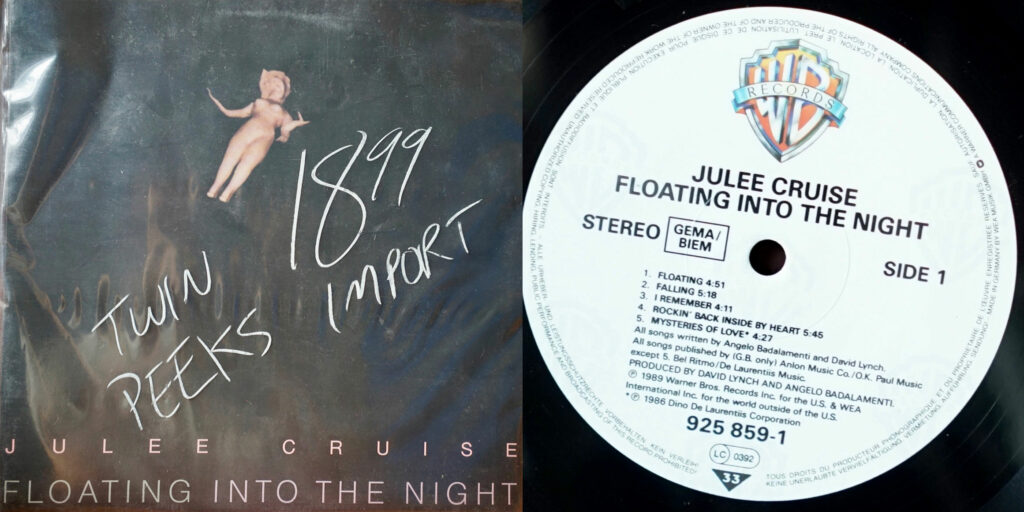
Full digital. Competent but unexciting. A little chalky, flubby in the bass. Sax textures are off. Not as magical as this song needs to sound…
Full vinyl. Possibly a little better than digital, but not a big difference. Thumpy and thuddy as per usual with this configuration — the bass is really a disaster. Sax texture is MUCH nicer, and the tone much more penetrating. Horns sound great with this configuration — but not bass.
Slight delay. Better treble detail on digital, higher higher and lower lows, more focus. Sax sounds a lot nicer on vinyl, textures generally nicer. But the thud. Even, I think.
S-2-s. Yeah, as above. Texture advantage enough to give a 5% edge to vinyl.
Verdict: vinyl is 5% better (20% regression)
11. Can, “Halleluwah,” Tago Mago (1971)
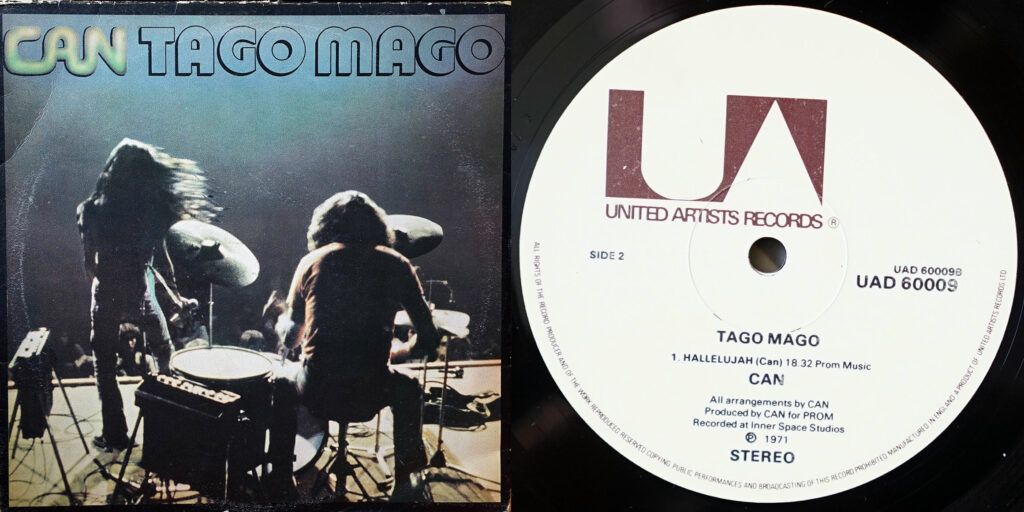
Full vinyl. Foggy, chalky at the start, as usual, though Damo’s voice comes through clearly. Head bopping now. When the drums start really pounding, it’s good: thick and maybe a little hazy, but powerful. Fine details sit over this nicely. Like Dungen, this one sounds good: one of those full-on slam-fest that seems to interact well with this configuration.
Full digital. More control, more detail, but less full-on audio assault. Comes across as a little hollow, harsh. Drums hit with less force. But definitely much more “hi-fi.” Even, probably, though quite different.
Slight delay. A little boomy on vinyl, but more pleasant overall. More authority on the bass, details are still presented clearly. More exciting, visceral sound. Digital is a little hollow, edgy by comparison. But digital has more detail, especially treble detail. Vinyl is better overall, maybe 10%, but definitely not nearly as good as it was last round.
S-2-s. The bass is just overwhelming in this setup. In some parts that works, in some parts it doesn’t. 5%.
Verdict: vinyl is 5% better (25% regression)
12. Bill Callahan, “Javelin Unlanding,” Dream River (2013)
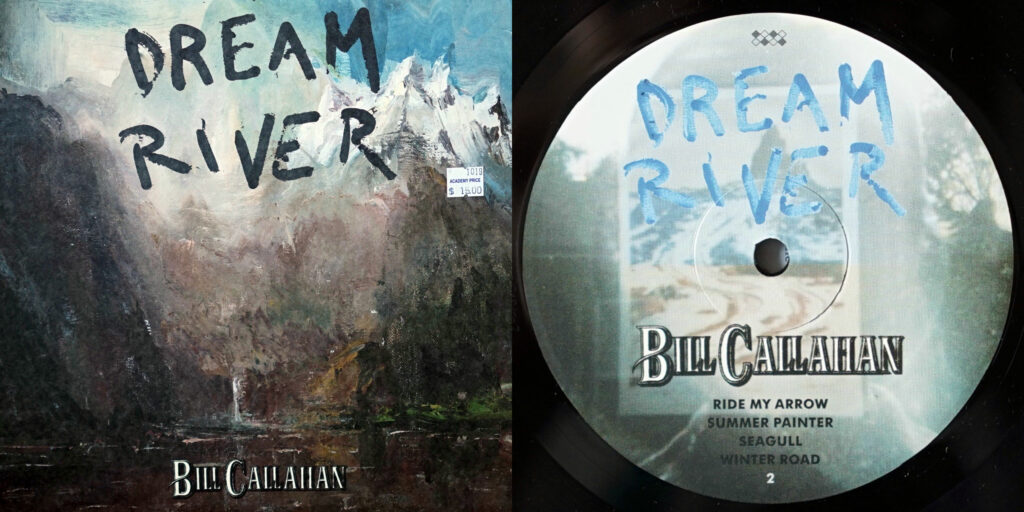
Full vinyl. This is one where the vinyl has sounded better almost from the start. Well, nothing special here so far. Distant and a little flat. And, yes, thuddy.
Full digital. Not much worse, but probably worse. The “pixel-barf” on this transfer is pretty gross. But the differences are far, far less apparent than in previous rounds.
Slight delay. Blech, something’s definitely up. Wider soundstage, some more natural sounds, no pixel-barf on vinyl. But better detail, more dynamic presentation on digital. It’s a wash, which is nuts.
S-2-s. I can’t be bothered to listen to any more. Next step, please!
Verdict: they sound equally bad (30% regression)
Next steps
As noted above, I didn’t waste any time proceeding to the next step. Listening to music with this configuration was a drag. So as soon as I finished this round of testing, I installed Linn Ekos tonearm.
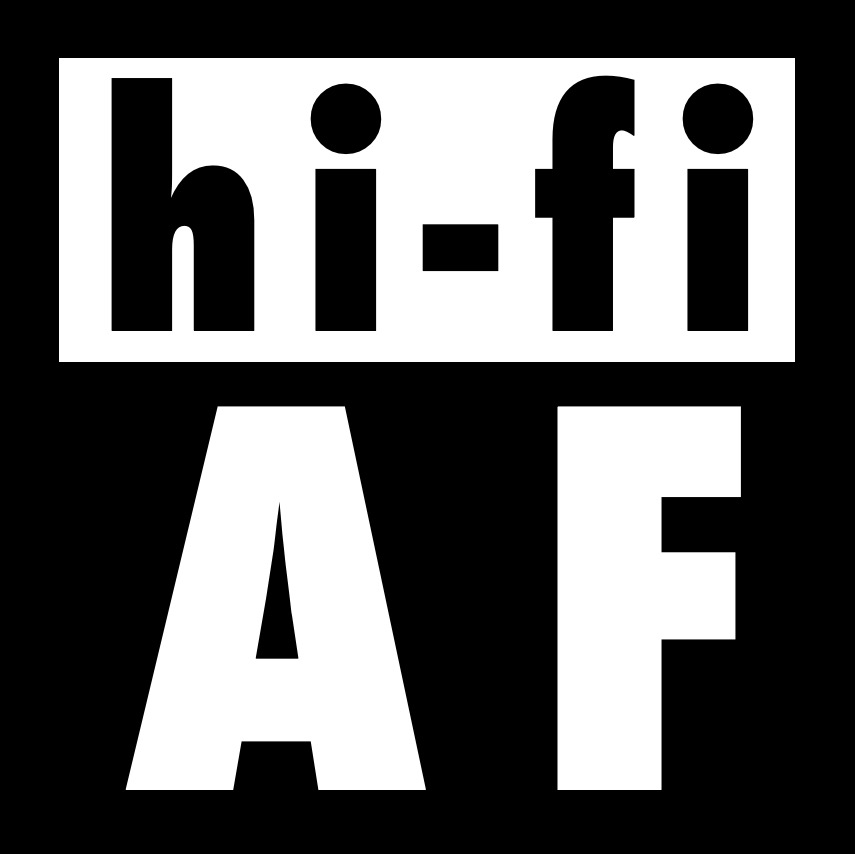
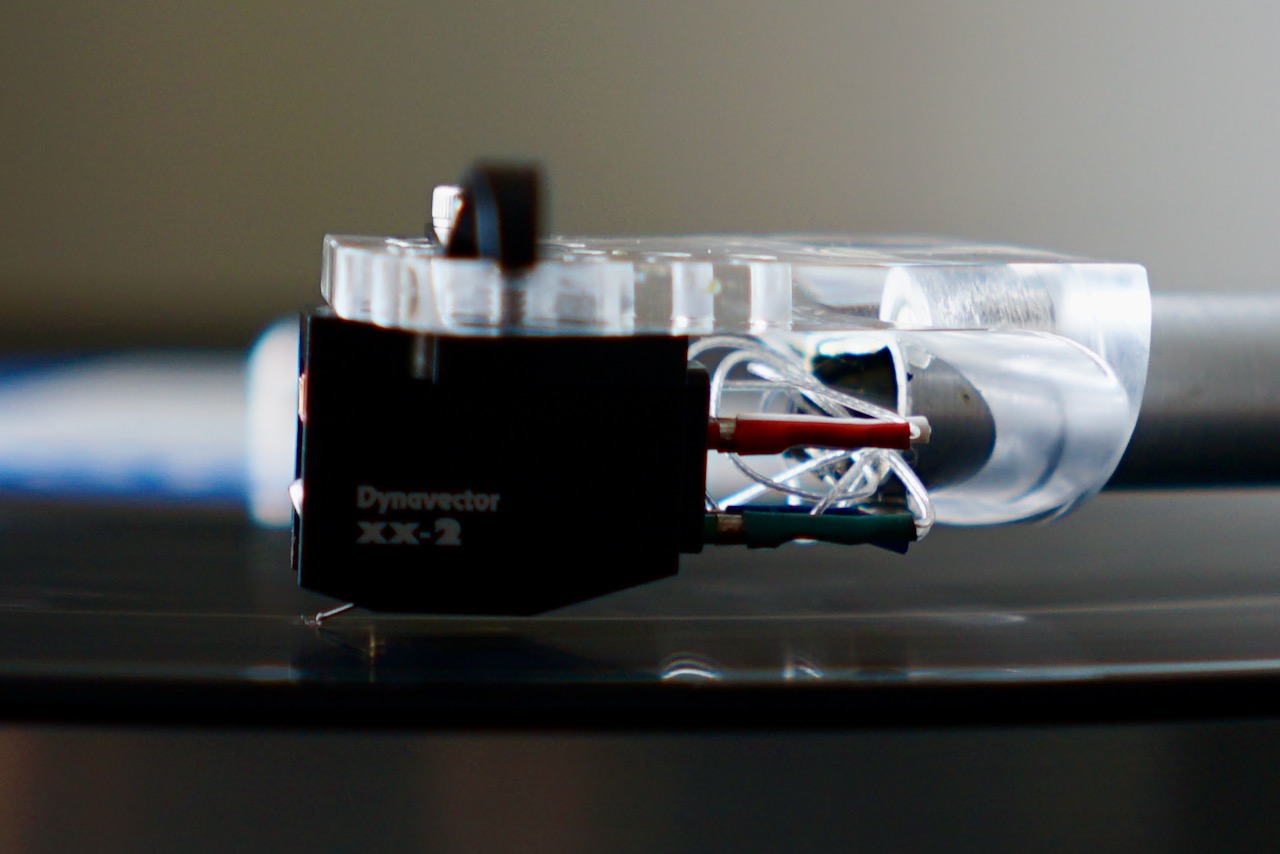
2 Comments
Join the discussion and tell us your opinion.
Please ignore my comment above! It was quite hasty on my part, and you really did not “totally trash” the cartridge in your review (I just feel you did not get the most out of what it can do. Or maybe a mismatch). I wanted to erase my comment, but can’t find a way to do so, forgive me. By the way, you have good musical taste, and nice to see Dungen mentioned!
Mark, I’ve removed your comment (which was not at all out of line!). I did try the Dynavector subsequently with a “proper” Mint LP Best Tractor (on an Ekos, and also on Aro) and I just never really did it for me — it always came across as a “fun” rock n’ roll cartridge that lacked finesse and “snap.” I’m sure it can sound amazing in other setups, but it never worked for me in mine. My next try, the Linn Troika, just immediately “did it” for me, to the point that I’ve lost all interest in trying other MC carts!